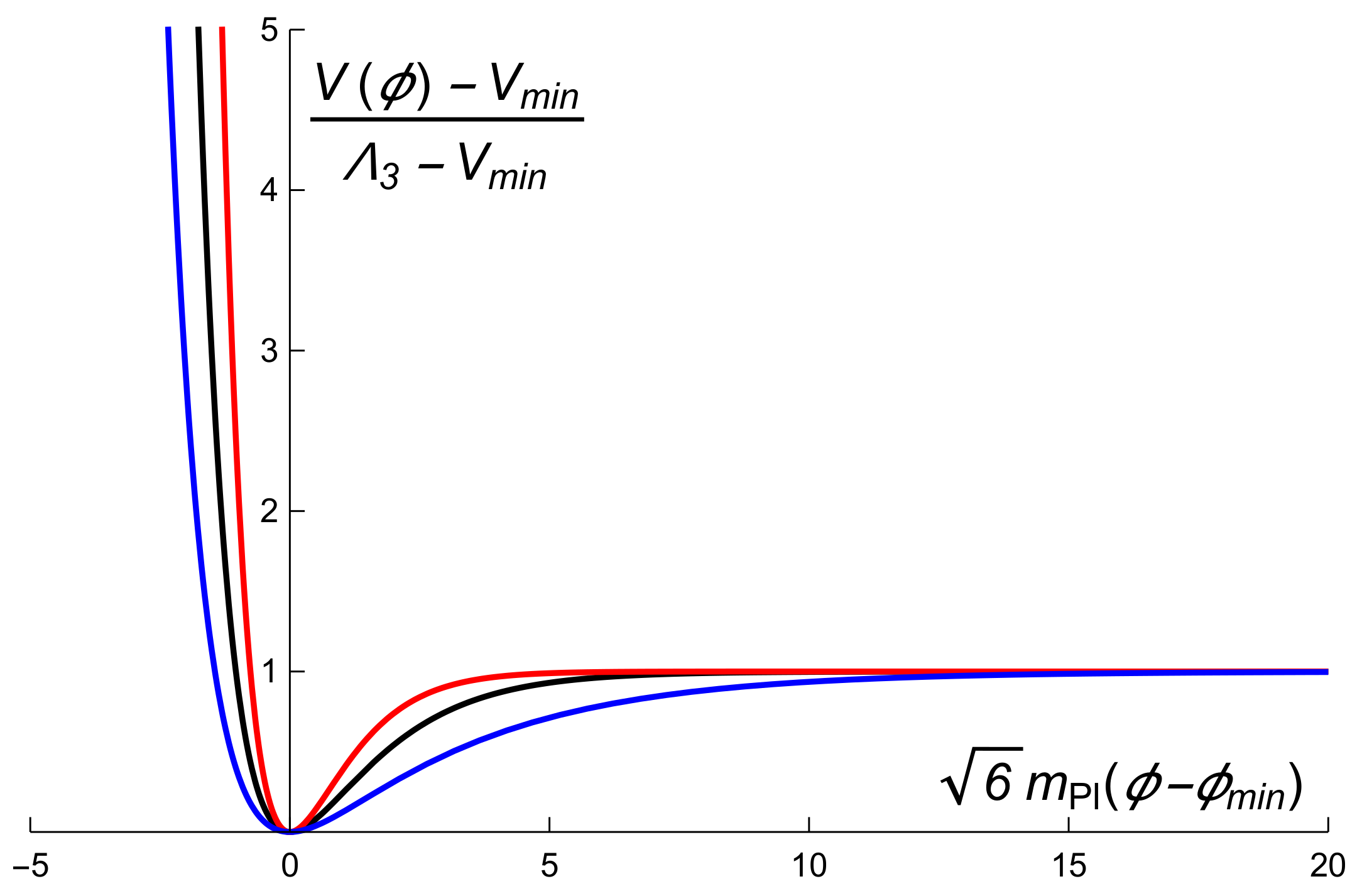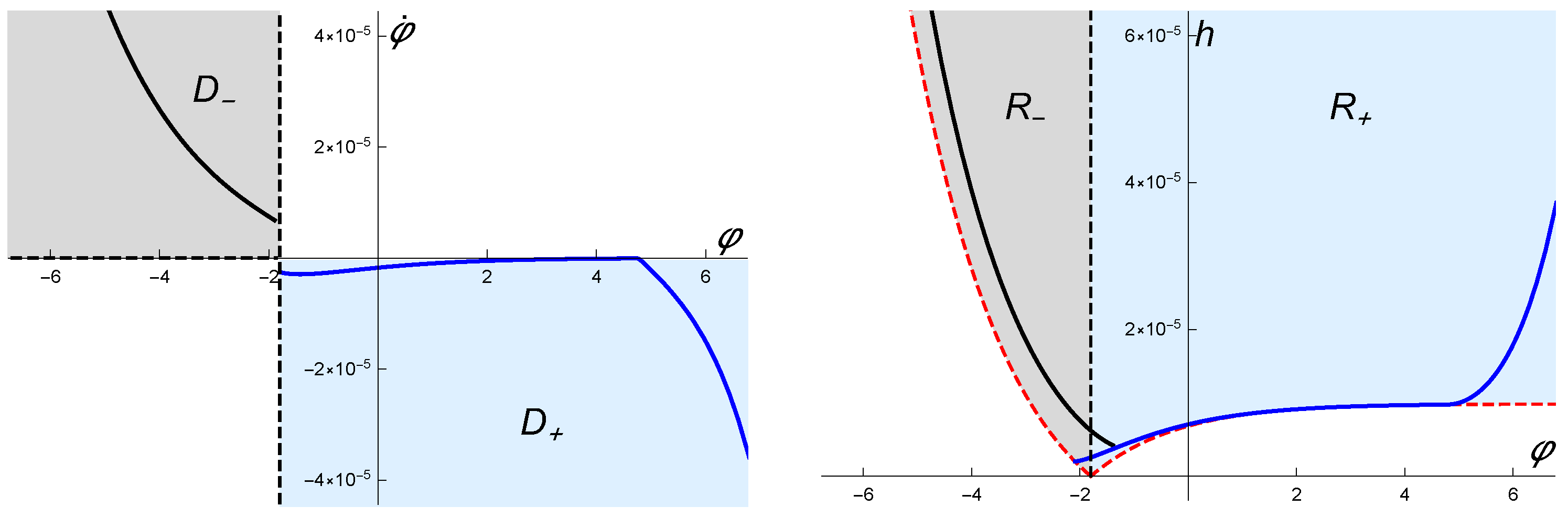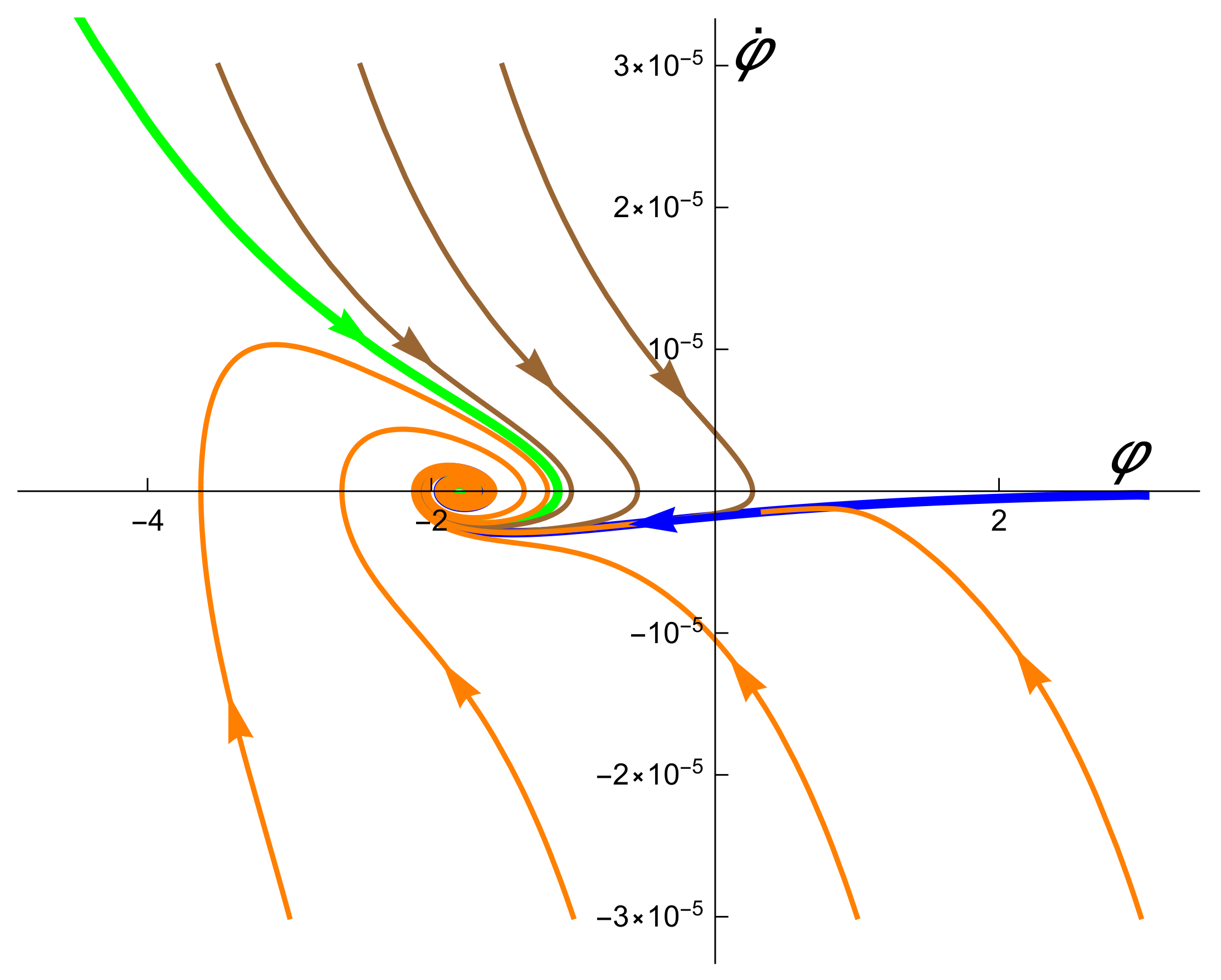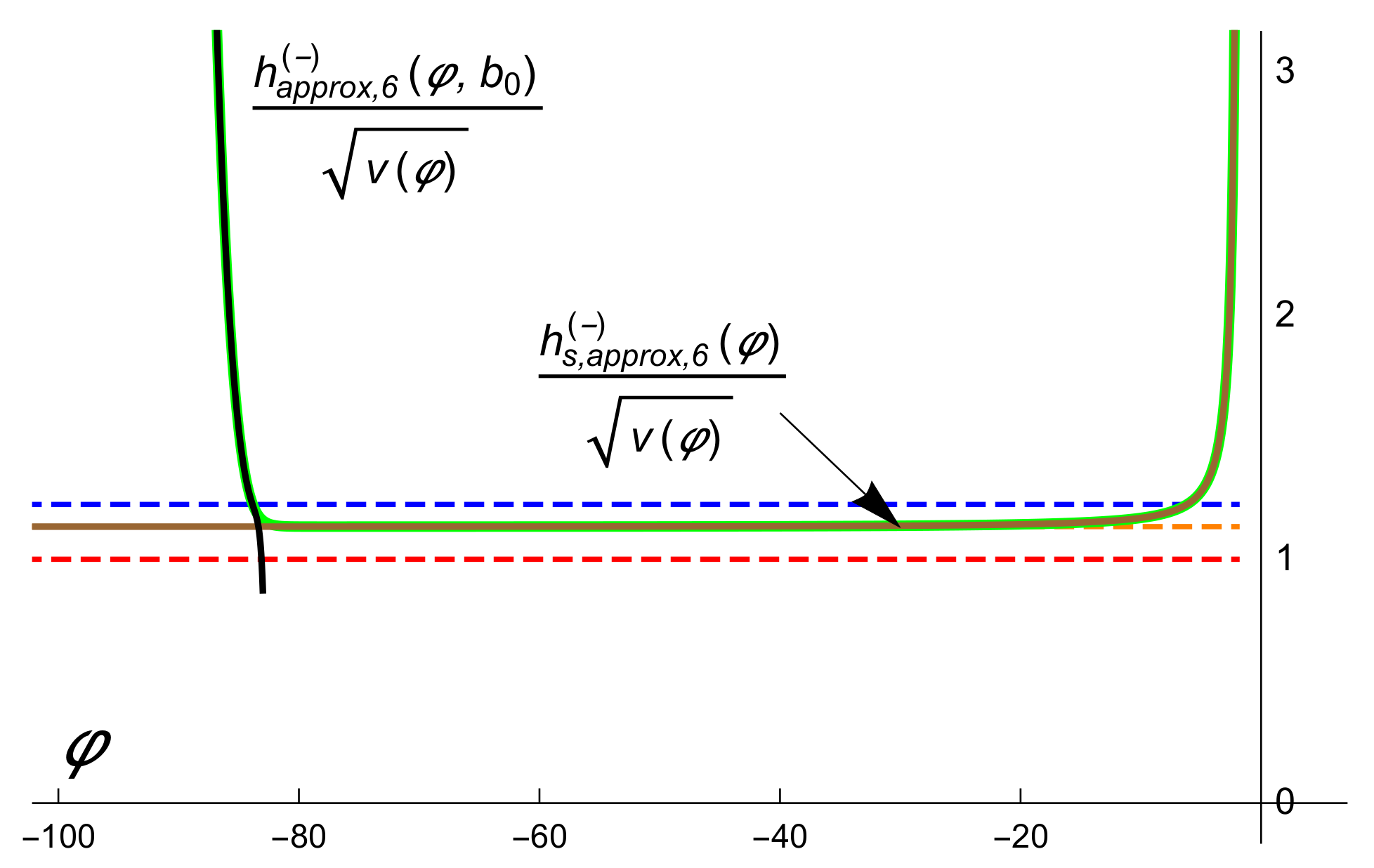Asymptotic Solutions of a Generalized Starobinski Model: Kinetic Dominance, Slow Roll and Separatrices
Abstract
:1. Introduction
2. Hamilton Jacobi Formulation
2.1. The Hamilton-Jacobi Equations
2.2. The KD Period. Asymptotic Solutions
2.3. Slow-Roll Stage and Separatrix Solutions
2.4. The Amount of Inflation
3. Expolinear Series for the Reduced Hubble Parameter in the KD Period
4. Asymptotic Series for Separatrix Solutions
5. Aplications
5.1. Approximate Solutions
5.2. Aplications to the Inflation Period
6. Conclusions
Author Contributions
Funding
Data Availability Statement
Conflicts of Interest
Appendix A. Logolinear Series for the Reduced Inflation Field φ (±) (t) and the Reduced Hubble Parameter h (±) (t)

References
- Starobinsky, A. A new type of isotropic cosmological models without singularity. Phys. Lett. B 1980, 91, 99. [Google Scholar] [CrossRef]
- Guth, A.H. Inflationary universe: A possible solution to the horizon and flatness problems. Phys. Rev. D 1981, 23, 347–356. [Google Scholar] [CrossRef] [Green Version]
- Linde, A.D. A new inflationary universe scenario: A possible solution of the horizon, flatness, homogeneity, isotropy and primordial monopole problems. Phys. Lett. B 1982, 108, 389–393. [Google Scholar] [CrossRef]
- Linde, A.D. Initial conditions for inflation. Phys. Lett. B 1985, 162, 281–286. [Google Scholar] [CrossRef]
- Mukhanov, V. Physical Foundations of Cosmology; Cambridge University Press: Cambridge, UK, 2005. [Google Scholar]
- Baumann, D. TASI Lectures on Inflation. TASI Lectures on Inflation. arXiv 2009, arXiv:0907.5424. [Google Scholar]
- Starobinskii, A. The perturbation spectrum evolving from a nonsingular initially de-Sitter cosmology and the microwave background anisotropy. Sov. Astron. Lett. 1983, 9, 302–304. [Google Scholar]
- Linde, A.D. Chaotic inflation. Phys. Lett. B 1983, 129, 177–181. [Google Scholar] [CrossRef]
- Kallosh, R.; Linde, A. Universality class in conformal inflation. J. Cosmol. Astropart. Phys. 2013, 2013, 002. [Google Scholar] [CrossRef] [Green Version]
- Akrami, Y.; Kallosh, R.; Linde, A.; Vardanyan, V. Dark energy, α-attractors, and large-scale structure surveys. J. Cosmol. Astropart. Phys. 2018, 2018, 041. [Google Scholar] [CrossRef] [Green Version]
- Liddle, A.R. Power-law inflation with exponential potentials. Phys. Lett. B 1989, 220, 502–508. [Google Scholar] [CrossRef]
- Fomin, I.; Chervon, S. Exact and slow-roll solutions for exponential power-Law inflation connected with modified gravity and observational constraints. Universe 2020, 6, 199. [Google Scholar] [CrossRef]
- Lasenby, A.; Doran, C. Closed universes, de Sitter space, and inflation. Phys. Rev. D 2005, 71, 063502. [Google Scholar] [CrossRef] [Green Version]
- Handley, W.; Brechet, S.; Lasenby, A.; Hobson, M.P. Kinetic initial conditions for inflation. Phys. Rev. D 2014, 89, 063505. [Google Scholar] [CrossRef] [Green Version]
- Handley, W.; Lasenby, A.; Hobson, M. Kinetically dominated curved universes: Logolinear series expansions. Phys. Rev. D 2019, 99, 123512. [Google Scholar] [CrossRef] [Green Version]
- Destri, C.; de Vega, H.; Sanchez, N.G. The pre-inflationary and inflationary fast-roll eras and their signatures in the low CMB multipoles. Phys. Rev. D 2010, 81, 063520. [Google Scholar] [CrossRef] [Green Version]
- Steinhardt, P.J.; Turner, M.S. Prescription for successful new inflation. Phys. Rev. D 1984, 29, 2162. [Google Scholar] [CrossRef] [Green Version]
- Stewart, E.D.; Lyth, D.H. A more accurate analytic calculation of the spectrum of cosmological perturbations produced during inflation. Phys. Lett. B 1993, 302, 171–175. [Google Scholar] [CrossRef] [Green Version]
- Liddle, A.R.; Parsons, P.; Barrow, J.D. Formalizing the slow-roll approximation in inflation. Phys. Rev. D 1994, 50, 7222. [Google Scholar] [CrossRef]
- Lidsey, J.E.; Liddle, A.R.; Kolb, E.W.; Copeland, E.J.; Barreiro, T.; Abney, M. Reconstructing the inflaton potential—An overview. Rev. Mod. Phys. 1997, 69, 373. [Google Scholar] [CrossRef]
- Bassett, B.A.; Tsujikawa, S.; Wands, D. Inflation dynamics and reheating. Rev. Mod. Phys. 2006, 78, 537–589. [Google Scholar] [CrossRef] [Green Version]
- Linde, A. Inflationary Cosmology. In Inflationary Cosmology; Lecture Notes in Physics; Springer: Berlin, Germany, 2008; Volume 738, pp. 1–54. [Google Scholar]
- Weinberg, S. Cosmology; Oxford University Press: Oxford, UK, 2008. [Google Scholar]
- Boyanovsky, D.; Destri, C.; de Vega, H.; Sanchez, N. The Effective Theory of Inflation in the Standard Model of the Universe and the CMB+LSS data analysis. Int. J. Mod. Phys. A 2009, 24, 3669–3864. [Google Scholar] [CrossRef] [Green Version]
- Haddadin, W.I.J.; Handley, W.J. Rapid numerical solutions for the Mukhanov-Sazaki equation. arXiv 2018, arXiv:1809.11095. [Google Scholar]
- Hergt, L.; Handley, W.; Hobson, M.; Lasenby, A. Constraining the kinetically dominated universe. Phys. Rev. D 2019, 100, 023501. [Google Scholar] [CrossRef] [Green Version]
- Hergt, L.; Handley, W.; Hobson, M.; Lasenby, A. Case for kinetically dominated initial conditions for inflation. Phys. Rev. D 2019, 100, 023502. [Google Scholar] [CrossRef] [Green Version]
- Hille, E.I. Ordinary Differential Equations in the Complex Domain; Courier Corporation: New York, NY, USA, 1997. [Google Scholar]
- Medina, E.; Alonso, L.M. Kinetic dominance and psi series in the Hamilton-Jacobi formulation of inflaton models. Phys. Rev. D 2020, 102, 103517. [Google Scholar] [CrossRef]
- Belinskii, V.A.; Grishchuk, L.P.; Zel’dovich, Y.B.; Khalatnikov, I.M. Inflationary stages in cosmological models with a scalar field. Sov. Phys. JETP 1985, 62, 195. [Google Scholar] [CrossRef]
- Álvarez, G.; Martínez Alonso, L.; Medina, E.; Vázquez, J.L. Separatrices in the Hamilton–Jacobi formalism of inflaton models. J. Math. Phys. 2020, 61, 043501. [Google Scholar] [CrossRef] [Green Version]
- Albrecht, A.; Steinhardt, P.J.; Turner, M.S.; Wilczek, F. Reheating an Inflationary Universe. Phys. Rev. Lett. 1982, 48, 1437. [Google Scholar] [CrossRef]
- Shtanov, Y.; Traschen, J.; Brandenberg, R. Universe reheating after inflation. Phys. Rev. D 1995, 51, 5438. [Google Scholar] [CrossRef] [PubMed] [Green Version]
- Álvarez, G.; Martínez Alonso, L.; Medina, E. Generalised asymptotic solutions for the inflaton in the oscillatory phase of reheating. Universe 2021, 7, 390. [Google Scholar] [CrossRef]
- Salopek, D.; Bond, J. Nonlinear evolution of long-wavelength metric fluctuations in inflationary models. Phys. Rev. D 1990, 42, 3936. [Google Scholar] [CrossRef] [PubMed]
- Lyth, D.H.; Liddle, A.R. The Primordial Density Perturbation: Cosmology, Inflation and the Origin of Structure; Cambridge University Press: Cambridge, UK, 2009. [Google Scholar]
- Baumann, D. Cosmology, Part III Mathematical Tripos; University Lecture Notes: Cambridge, UK, 2012. [Google Scholar]
- Dodelson, S. Modern Cosmology; Academic Press: San Diego, CA, USA, 2003. [Google Scholar]
- Martin, J. The Theory of Inflation. 200th Course of Enrico Fermi School of Physics: Gravitational Waves and Cosmology. arXiv 2018, arXiv:1807.11075. [Google Scholar]
- John, F. Partial Differential Equations; Springer: New York, NY, USA, 1982. [Google Scholar]
- Foster, S. Scalar field cosmological models with hard potential walls. arXiv 1998, arXiv:gr-qc/9806113. [Google Scholar]
- Bell, E.T. Exponential polynomials. Ann. Math. 1934, 258–277. [Google Scholar] [CrossRef]









Publisher’s Note: MDPI stays neutral with regard to jurisdictional claims in published maps and institutional affiliations. |
© 2021 by the authors. Licensee MDPI, Basel, Switzerland. This article is an open access article distributed under the terms and conditions of the Creative Commons Attribution (CC BY) license (https://creativecommons.org/licenses/by/4.0/).
Share and Cite
Medina, E.; Alonso, L.M. Asymptotic Solutions of a Generalized Starobinski Model: Kinetic Dominance, Slow Roll and Separatrices. Universe 2021, 7, 500. https://doi.org/10.3390/universe7120500
Medina E, Alonso LM. Asymptotic Solutions of a Generalized Starobinski Model: Kinetic Dominance, Slow Roll and Separatrices. Universe. 2021; 7(12):500. https://doi.org/10.3390/universe7120500
Chicago/Turabian StyleMedina, Elena, and Luis Martínez Alonso. 2021. "Asymptotic Solutions of a Generalized Starobinski Model: Kinetic Dominance, Slow Roll and Separatrices" Universe 7, no. 12: 500. https://doi.org/10.3390/universe7120500
APA StyleMedina, E., & Alonso, L. M. (2021). Asymptotic Solutions of a Generalized Starobinski Model: Kinetic Dominance, Slow Roll and Separatrices. Universe, 7(12), 500. https://doi.org/10.3390/universe7120500






